Thyristor Arc Eliminator for Protection of Low Voltage Electrical Equipment
Abstract
:1. Introduction
1.1. Motivation
1.2. Literature Review
- −
- motor drive systems using frequency converters (inverters), in which an arc fault may not be eliminated by the protection system [12],
- −
- industrial manufacturing facilities where capacitors play a role of reactive power compensation [13],
- −
- power systems using photovoltaic panels, where the bypass system can suppress overvoltages, which can induce excessive overheating of cells and, as a result, cause permanent damage to photovoltaic cells [14],
- −
- a hybrid circuit breaker, which is a combination of a mechanical switch and a semiconductor bypass branch, where the bypass system plays the role of un-arc circuit current commutation [15],
- −
- a hybrid vacuum switch, where the vacuum chamber is bypassed by a semiconductor circuit, which commutates the flow of the electric current without an arc [16],
- −
- an arc protection system in electric vehicles powered with constant voltage [17].
1.3. Contributions and Paper Organization
2. Thyristor Arc Fault Eliminator
2.1. Principle of Operation
2.2. Circuit Design
3. Experiments Results
4. Discussion
5. Conclusions
Author Contributions
Funding
Conflicts of Interest
Nomenclatures
| Abbreviations | |
| AE | arc eliminator |
| AC | power source (Alternating Current) |
| Tr | transformer |
| CB | circuit breaker |
| Th1, Th2 | thyristors |
| Parameters | |
| RkQ | resistance of the power system |
| RTr | resistance of the transformer |
| RL | resistance of the power line |
| RLOAD | resistance of load |
| R | resistance of the fault circuit |
| RQ | the measured resistance of the short circuit loop |
| RR | serial resistance in the circuit of the arc generator |
| LkQ | inductance of the power system |
| LL | inductance of the power line |
| L | inductance of the fault circuit |
| LQ | the measured inductance of the short circuit loop |
| LR | serial inductance in the circuit of the arc generator |
| ZLoad | impedance of load |
| ZQ | the measured impedance of the short circuit loop |
| ZR | serial impedance in the circuit of the arc generator |
| XTr | reactance of the transformer |
| XLOAD | reactance of load |
| I, i | effective and instantaneous current values at characteristic points of the circuit |
| I”K | the effective value of the initial short circuit current |
| Ia | current in the branch of the arc source |
| ITh | current in the thyristor branch |
| iAC | alternating-current component |
| iDC | direct-current component |
| ia | the instantaneous value of arc current |
| U, u | effective and instantaneous voltage values at characteristic points of the circuit |
| Um | supply voltage amplitude |
| Ua | the value of the arc voltage |
| U1 | supply voltage |
| U2 | voltage on the electrodes of the arc source |
| ua | the instantaneous value of the arc voltage |
| u1 | the instantaneous value of the supply voltage |
| u2 | the instantaneous voltage value on the electrodes of the arc source |
| ω | pulsation voltage values or current values |
| ψ | phase angle of voltage at the moment of short circuit |
| φz | the short circuit impedance argument |
| Wa | arc energy |
| Ta | the duration of the electric arc |
References
- Yang, L.; Qiu, W.; Huang, J.; Hao, Y.; Fu, M.; Hou, S.; Li, L. Comparison of conductor-temperature calculations based on different radial-position-temperature detections for high-voltage power cable. Energies 2018, 11, 117. [Google Scholar] [CrossRef]
- Lu, Q.; Ye, Z.; Zhang, Y.; Wang, T.; Gao, Z. Analysis of the effects of arc volt-ampere characteristics on different loads and detection methods of series arc faults. Energies 2019, 12, 323. [Google Scholar] [CrossRef]
- Yang, Q.; Wang, J.; Sima, W.; Chen, L.; Yuan, T. Mixed over-voltage decomposition using atomic decompositions based on a damped sinusoids atom dictionary. Energies 2011, 4, 1410–1427. [Google Scholar] [CrossRef]
- Yin, Z.; Wang, L.; Zhang, Y.; Gao, Y. A novel arc fault detection method integrated random forest, improved multi-scale permutation entropy and wavelet packet transform. Electronics 2019, 8, 396. [Google Scholar] [CrossRef]
- Whittingham, R.B. The Blame Machine. Why Human Error Causes Accidents, 1st ed.; Elsevier Butterworth Heinemann Linacre House: Burlington, MA, USA, 2004; pp. 237–242. [Google Scholar]
- Kay, J.A.; Kumpulainen, L. Maximizing protection by minimizing arcing times in medium-voltage systems. IEEE Tech. Ind. Appl. 2013, 49, 1920–1927. [Google Scholar] [CrossRef]
- Dugan, T. Reducing the flash hazard. IEEE Ind. Appl. Mag. 2007, 13, 51–58. [Google Scholar] [CrossRef]
- Hodder, M.; Vilchek, W.; Croyle, F.; McCue, D. Practical arc-flash reduction. IEEE Ind. Appl. Mag. 2006, 12, 22–29. [Google Scholar] [CrossRef]
- Hussain, G.A. Method for Arc-Flash Protection in Medium Voltage and Low Voltage Switchgear. Ph.D. Thesis, Aalto University, Helsinki, Finland, 2015. [Google Scholar]
- Zhang, Z.; Ma, B.; Friberg, A. Thyristor working as arc eliminator protecting electrical apparatus in low voltage power system. In Proceedings of the IEEE International Conference on Industrial Technology (ICIT), Seville, Spain, 17–19 March 2015; pp. 1216–1219. [Google Scholar]
- Yang, K.; Zhang, R.; Yang, J.; Liu, C.; Chen, S.; Zhang, F. A novel arc fault detector for early detection of electrical fires. Sensors 2016, 16, 500. [Google Scholar] [CrossRef] [PubMed]
- Boren, S.G. Intelligence Automatic Bypass for a Motor Control Device Fault. U.S. Patent US20040252423A1, 16 December 2004. [Google Scholar]
- Bhargava, B.; Haas, R.G. Thyristor protected series capacitors project at Southern California Edison Co. In Proceedings of the IEEE Power Engineering Society Summer Meeting (PESS), Chicago, IL, USA, 21–25 July 2002; pp. 241–246. [Google Scholar]
- Pulvirenti, F.; La Scala, A.; Pennisi, S. Low voltage-drop bypass switch for photovoltaic applications. In Proceeding of the IEEE International Symposium on Circuits and Systems (ISCAS), Seoul, Korea, 20–23 May 2012; pp. 2283–2286. [Google Scholar]
- Backman, M.; Demetriades, G.; Shukla, A. Hybrid Circuit Breaker. European Patent Patent No. EP2465129B1, 24 April 2013. [Google Scholar]
- Liu, L.; Zhuang, C.; Wang, Z.; Jiang, Z.; Wu, J.; Chen, B. A hybrid DC vacuum circuit breaker for medium voltage: Principle and first measurements. IEEE Tech. Power Deliv. 2015, 30, 2096–2101. [Google Scholar] [CrossRef]
- Naidu, M.; Schoepf, T.J.; Gopalakrishnan, S. Arc fault detection scheme for 42-V automotive DS networks using current shunt. IEEE T. Power Electr. 2006, 21, 633–639. [Google Scholar] [CrossRef]
- Hatsagi, B. Electromagnetic Modelling and Testing of a Thomson Coil Based Actuator. Master’s Thesis, KTH Royal Institute of Technology, Stockholm, Sweden, 2017. [Google Scholar]
- Pei, X.; Smith, A.C.; Shuttleworth, R.; Vilchis-Rodriguez, D.S.; Barnes, M. Fast operating moving coil actuator for vacuum interrupter. IEEE Tech. Energy Convers. 2017, 32, 931–940. [Google Scholar] [CrossRef]
- Bissal, A.; Eriksson, A.; Magnusson, J.; Engdahl, G. Hybrid multi-physics modeling of an ultra-fast electro-mechanical actuator. Actuators 2015, 4, 314–335. [Google Scholar] [CrossRef]
- Peng, C.; Husain, I.; Huang, A.Q. Evaluation of design variables in Thompson coil based operating mechanisms for ultra-fast opening in hybrid AC and DC circuit breakers. In Proceedings of the IEEE Applied Power Electronics Conference and Exposition (APEC), Charlotte, NC, USA, 15–19 March 2015; pp. 2325–2332. [Google Scholar]
- Oeberg, A.; Chimento, F.; Qin, J.; Wang, L.; Jeppsson, O. Bypass Switch Assembly. U.S. Patent US9099268B2, 4 August 2015. [Google Scholar]
- Tirmizi, A.A. Pyrotechnic Circuit Breaker. U.S. Patent US7239225B2, 3 July 2007. [Google Scholar]
- Partyka, R. Investigation of Fault-Arcs Effects in Enclosed Switchgear, 1st ed.; Gdansk University of Technology Publisher: Gdansk, Poland, 2008; pp. 22–96. (In Polish) [Google Scholar]
- The Catalogue of Power Semiconductor Devices. Thyristors. Available online: http://delibra.bg.polsl.pl/Content/30503/BCPS_34289_1986_Tyrystory---przyrzad.pdf (accessed on 3 July 2019).


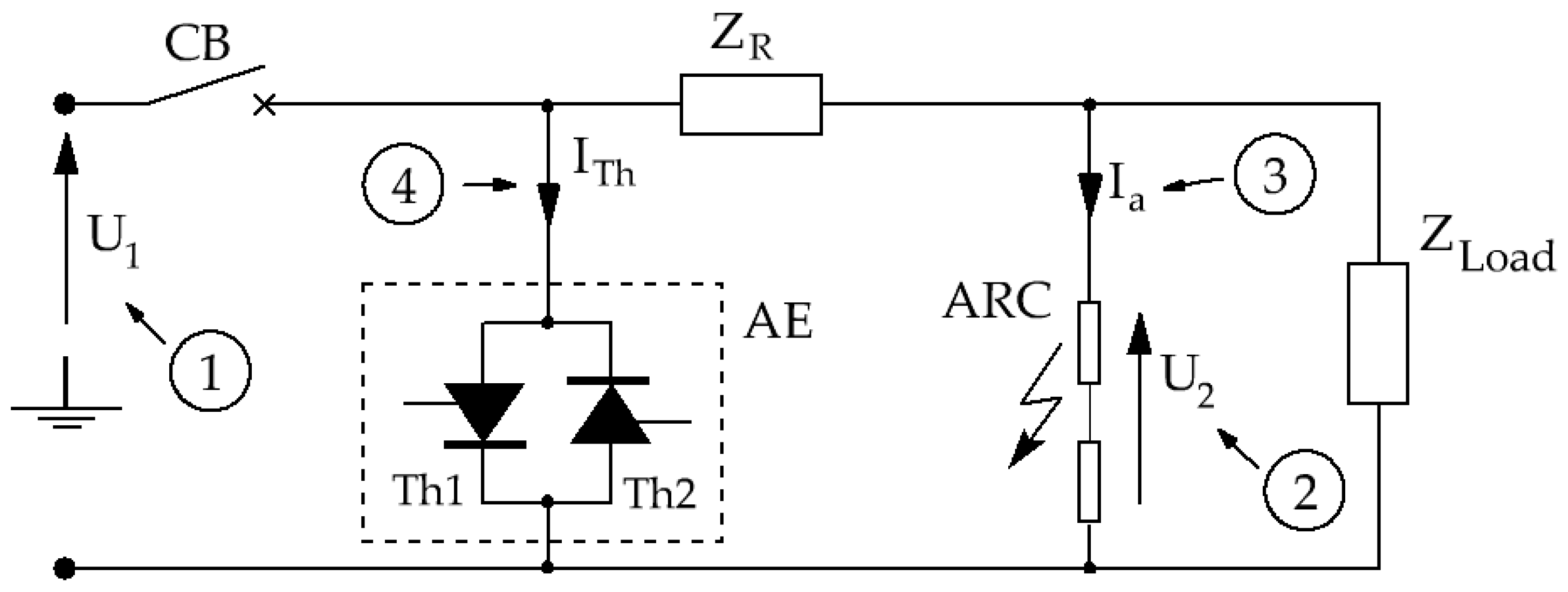

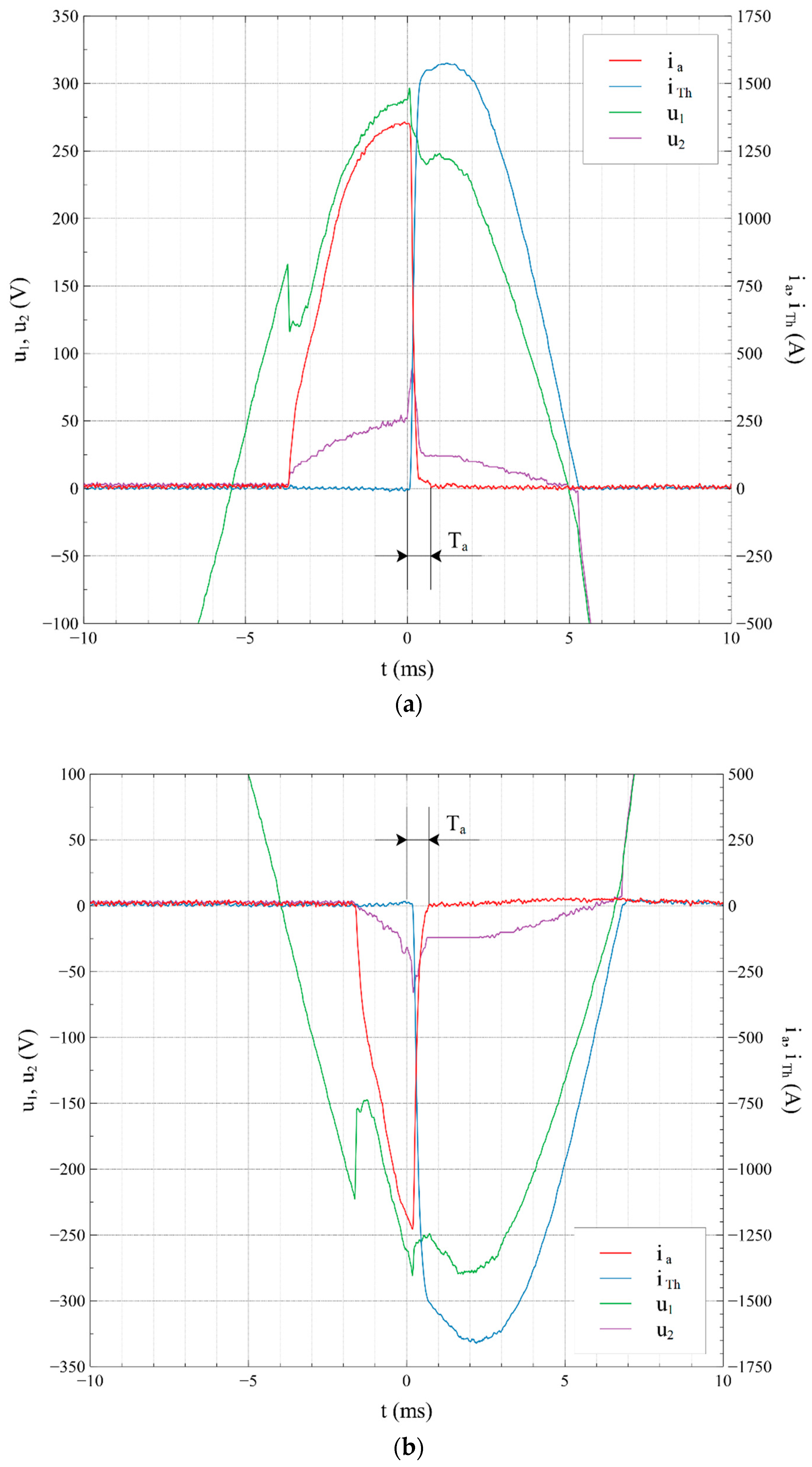
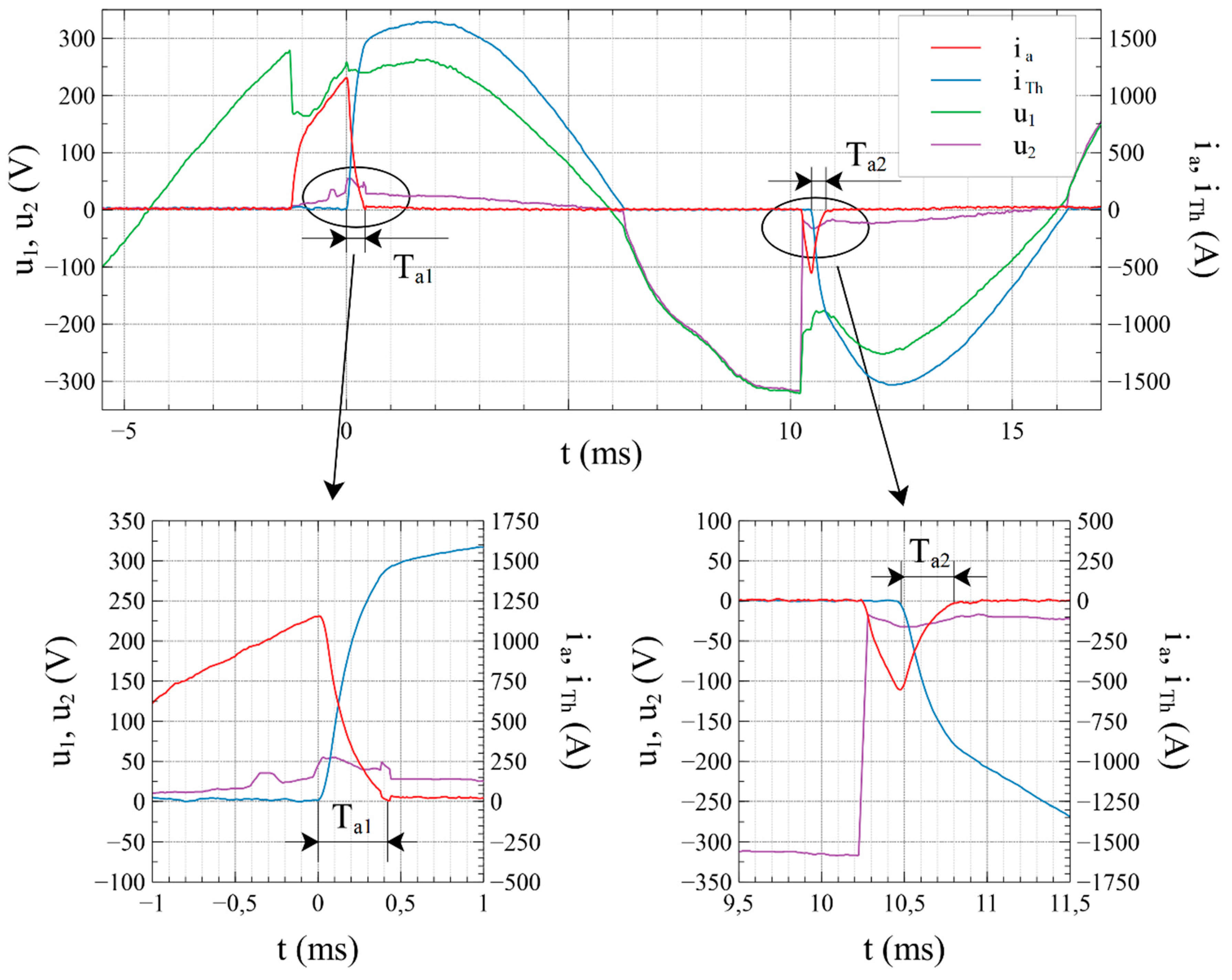
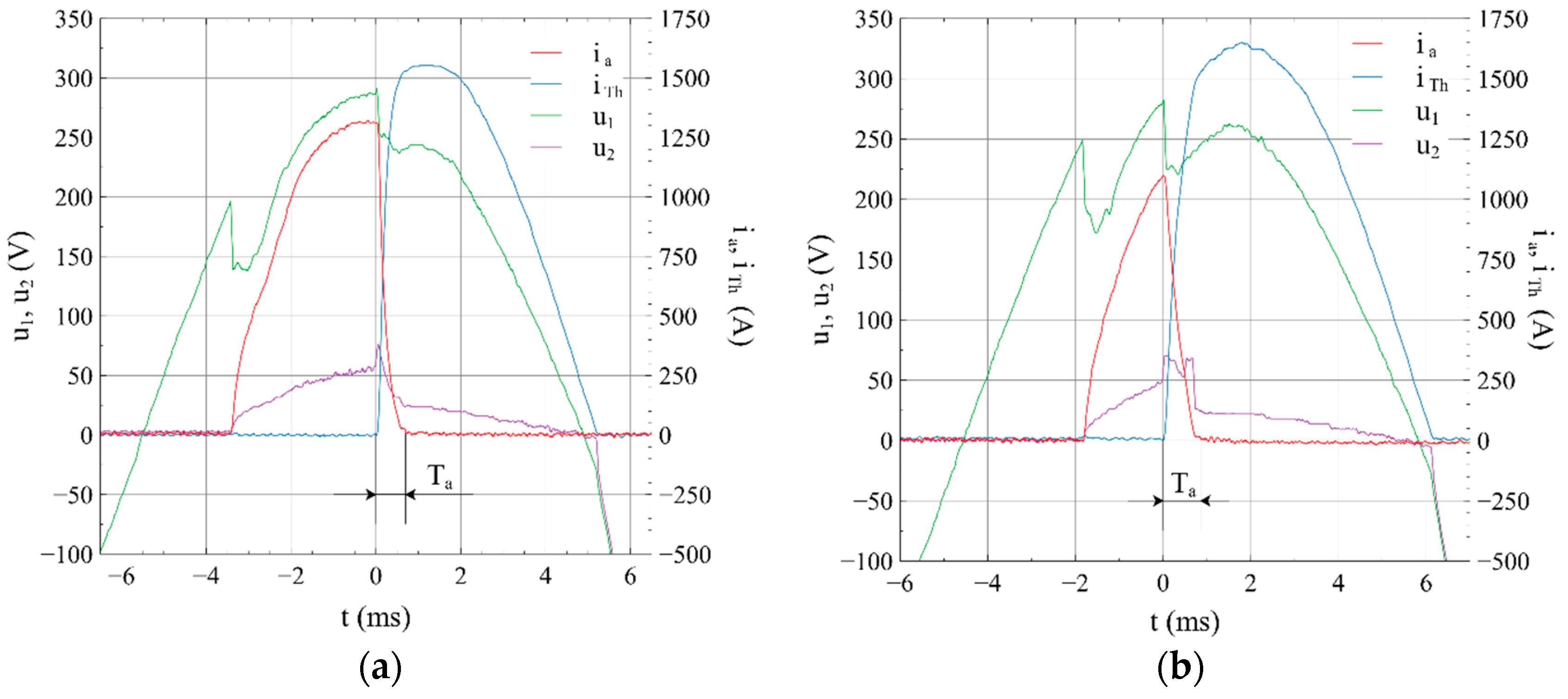
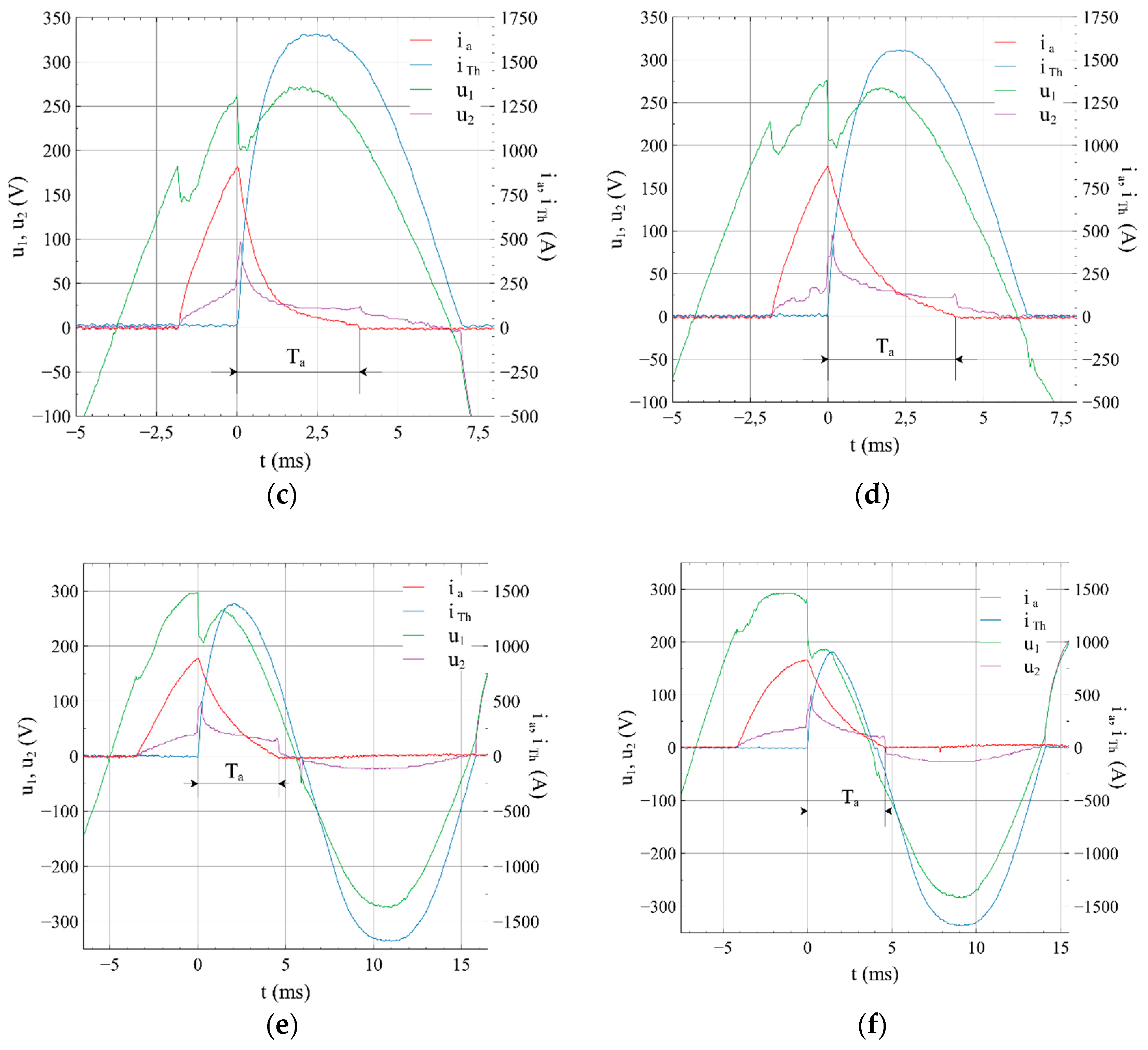
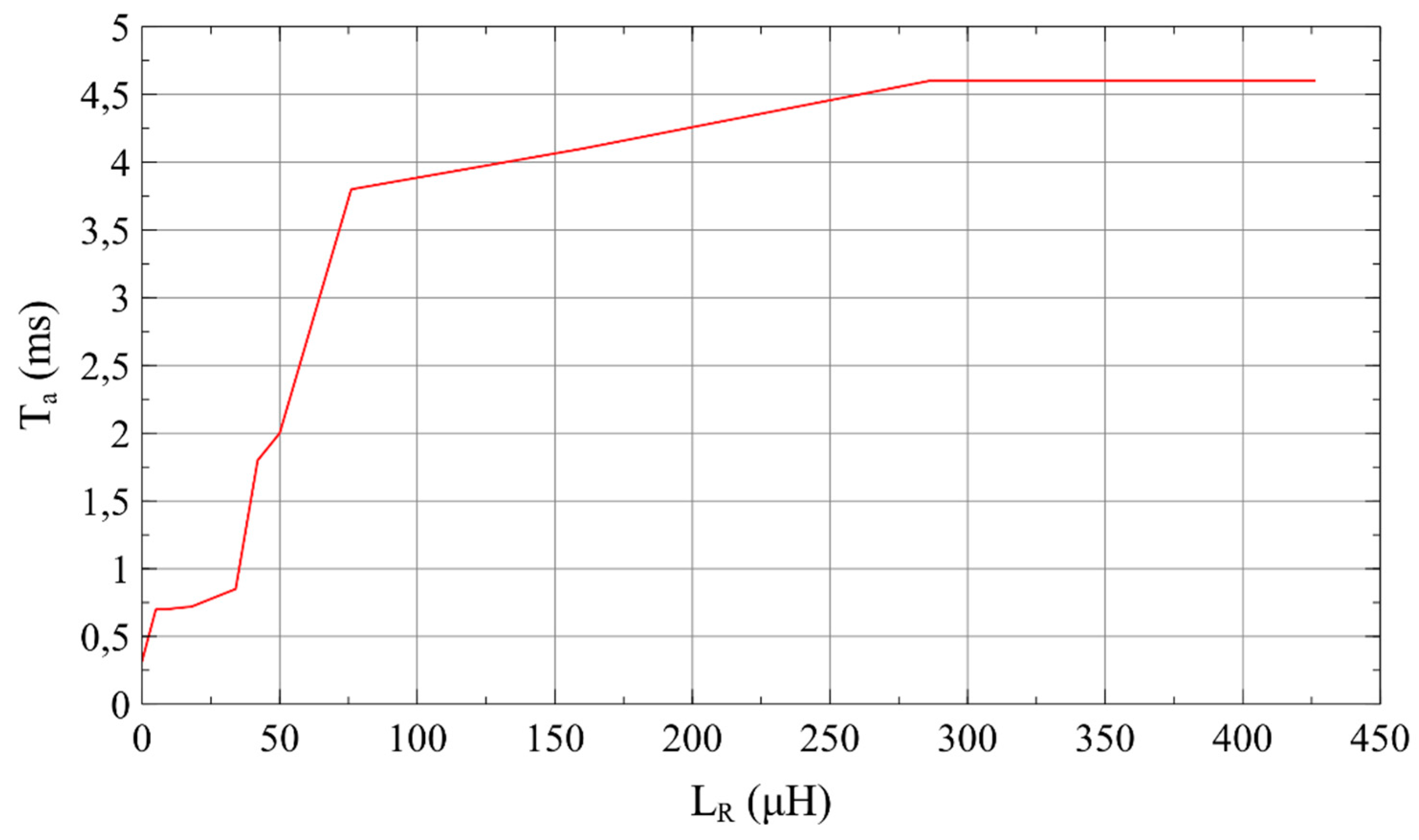
| Parameter | Value |
|---|---|
| Surge current ITSM [A] | 1260 |
| Repetitive peak reverse voltage URRM [V] | 1200 |
| I2t value [A2s] | 7900 |
| Rate of rise of on-state current repetitive di/dt [A/µs] | 50 |
| Critical rate of raise of off-state voltage du/dt [V/µs] | 1000 |
| Circuit commutated turn-off time (typical) tq [µs] | 20 |
| Turn-on time (typical) tON [μs] | 4 |
| Operating junction temperature Ti [°C] | 125 |
| No | Load LR [μH] | Arc Time Ta [ms] |
|---|---|---|
| 1 | 0 | 0.32–0.72 |
| 2 | 5 | 0.7 |
| 3 | 8.4 | 0.7 |
| 4 | 18 | 0.72 |
| 5 | 34 | 0.85 |
| 6 | 42 | 1.8 |
| 7 | 50 | 2 |
| 8 | 76 | 3.8 |
| 9 | 160 | 4.1 |
| 10 | 286 | 4.6 |
| 11 | 426 | 4.6 |
© 2019 by the authors. Licensee MDPI, Basel, Switzerland. This article is an open access article distributed under the terms and conditions of the Creative Commons Attribution (CC BY) license (http://creativecommons.org/licenses/by/4.0/).
Share and Cite
Nowak, K.; Janiszewski, J.; Dombek, G. Thyristor Arc Eliminator for Protection of Low Voltage Electrical Equipment. Energies 2019, 12, 2749. https://doi.org/10.3390/en12142749
Nowak K, Janiszewski J, Dombek G. Thyristor Arc Eliminator for Protection of Low Voltage Electrical Equipment. Energies. 2019; 12(14):2749. https://doi.org/10.3390/en12142749
Chicago/Turabian StyleNowak, Karol, Jerzy Janiszewski, and Grzegorz Dombek. 2019. "Thyristor Arc Eliminator for Protection of Low Voltage Electrical Equipment" Energies 12, no. 14: 2749. https://doi.org/10.3390/en12142749





